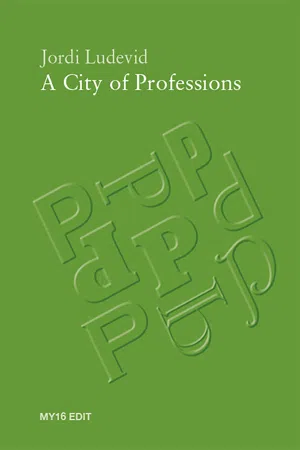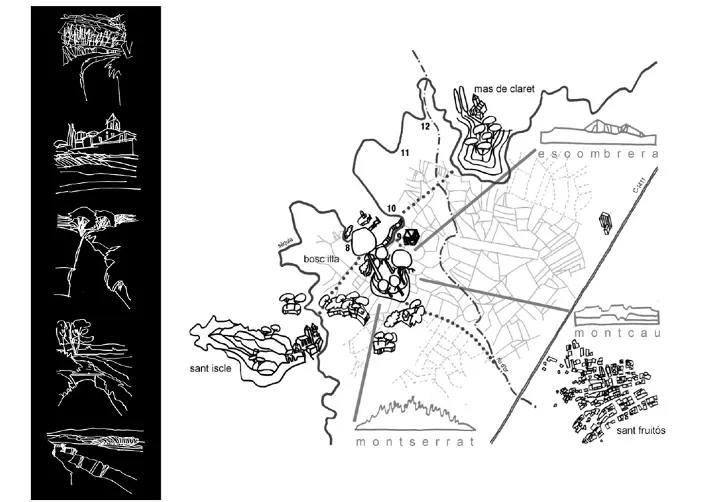![]()
VIII. ISla Forest
The Llobregat basin, Pla de Bages, Sant Iscle hermitage, Montserrat. A habitat, a strategic biotope, a characteristic element of the landscape.
VIII. A Difficult Context
It has been a catastrophe to drag the middle class into the precariat. Now 51% of young university graduates are unemployed, and those who have jobs have jobs far below their qualifications. The great changes in history have never come from the dirt poor, but from the frustration of people with great expectations were never fulfilled.
Zygmunt Bauman
Technical rationality and an accelerated constriction of professional autonomy combine to eradicate the essential idea of preparation for professional knowledge or craft.
Donald Schön
For the vast majority of the world’s professionals, and even for the professional fact itself, the existence of an extremely difficult economic and socio-cultural context is clear – a context fraught with uncertainties.
However, any strategy to redirect this situation towards a better one will no doubt require a consistent analysis in order to understand this new context and its main active, ongoing processes. What are the differences? what are the difficulties? What are those processes?
Since we need an approach to this new reality, it is worth first reviewing and describing the economic business foundations (1) from which the professions are exercised, then recalling some of the social changes (2) that have occurred (including the digital disruption and the crisis of the social pact) and, last but not least, looking at the decisive issue of de-professionalisation (3), understood as describing of current real threats to the professional fact and professionals, not limited to their possible disappearance. A daunting task.
![]()
Professionals’ Economic and Business Foundations
During the 20th century, the entrepreneurial mode of professional work underwent spectacular changes, mainly based on the process of progressive «salarisation» – i.e. the result of the consolidation of salaried work as the majority of employment. However, still today, when one claims to be a professional, it is often understood that he or she is self-employed, in an independent business format, of which he or she is also most likely the sole proprietor. Of course, there are still professionals in the world who operate under this classic format, but they are in the minority. It seems useful, thus, to clarify this question, which is crucial in its scope and decisive in the general context of precariousness, which we will discuss below.
It is worth advancing that, whatever the business format in which one works, the most important thing is the relationship, in each specific case, between the «autonomy» of the professional and the business «hierarchy» or «discipline» to which he or she is subject within a given organisation. There is no such thing as zero autonomy and no such thing as complete independence. So we have no choice but to address this significant dilemma of autonomy, in contractual terms and, of course, also conceptually and morally. The outcome will depend on «the parties» to the contract, their «values» and their positioning.
Clearly, the term «liberal professions» has become very popular – so much so that it has influenced the general interpretation of the professional phenomenon. It seems to suggest that professionals are «only» those who are self-employed, completely independent and with an absolute entrepreneurial base. This is a mistake. As we mentioned above, the word liberal historically referred to ‘the condition of a free, autonomous citizen, practicing under conditions of freedom’. Thus, today, a majority of the world’s professionals are, or theoretically can be, liberal professionals, as free citizens, theoretical holders of autonomy as qualified specialists with the responsibility that characterises them. But are they really? Do they really have autonomy?
Business Typologies
At the end of the 20th century, the majority of professionals around the world were already working as salaried employees. However, in terms of their relationship with the profession, not all companies that have recruited professionals in the 20th century are the same. Thus, it is important and of great practical use to be able to distinguish the different existing typologies of companies in which professionals work and to be able to identify one’s own. Professor Richard H. Hall, in one of his studies from the 1960s, proposed a threefold distinction between autonomous organisations, heteronomous organisations and professional departments.
An organisation is autonomous if it is made up solely of professionals who form the administrative hierarchy of the organisation. As a consequence, it is dominated by professional values. Both traditional single-person practices and today’s single or multi-professional professional partnerships fall into this first type of business organisation.
Secondly, there are heteronomous organisations or companies, which differ from the previous ones in that the professionals working in them are subject to an external, non-professional hierarchy, since they are working in companies that are not made up solely of professionals.
Finally, Hall argues that professional departments, within larger organisations, are a special type where it is not easy to know in advance whether professionals can exercise control over their work and how much discretionary power they enjoy.
Thus, before signing a contract, a professional would be wise identify the company for which he or she is going to provide services in order to better negotiate the content of the contract and to understand the company’s values. The debate between administrative and professional hierarchies, between formal authority and the authority of expertise, between rigour and relevance, is often the source of conflict and has a long history.
In any case, the logic of professionals, where it exists, offers practical knowledge and a focus on people – philo technè and philo anthropoiè – independently of what it may be worth in a given business dynamic, which may be profit-oriented or otherwise. Professionals all over the world know that this professional contribution is not always easy. Donald Schön described what he called «the pressure game» in 1992:
Superimposed on our basic picture of the institutionalized dilemma of rigor or relevance is a more recent complication: an uneven but nevertheless significant resurgence of technical rationality and an accelerating constriction of professional autonomy combine to squeeze out the very idea of education for professional wisdom or artistry. And this is happening just as some factions, in some schools, are becoming newly aware of the need for something like a reflective practicum. In its most dramatic form, this squeeze play threatens the very existence of the professions and professional education – at least as we have known them.
Whether autonomous, heteronomous or departmental, it must therefore be concluded that, as far as professional values and principles are concerned, not all companies are the same, nor do they have to be, and it is important to be aware of them before signing a contract.
From the Wage-earning of the 20th Century to the Individualisation of the 21st...

